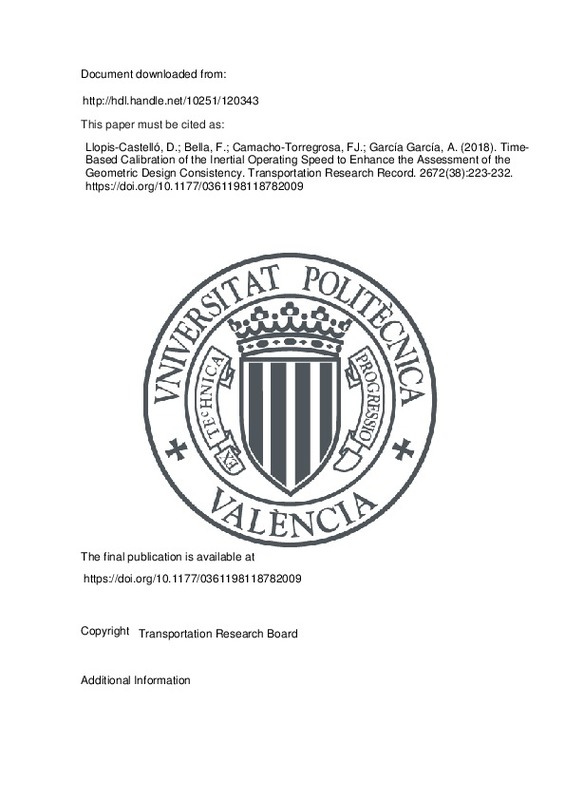JavaScript is disabled for your browser. Some features of this site may not work without it.
Buscar en RiuNet
Listar
Mi cuenta
Estadísticas
Ayuda RiuNet
Admin. UPV
Time-Based Calibration of the Inertial Operating Speed to Enhance the Assessment of the Geometric Design Consistency
Mostrar el registro sencillo del ítem
Ficheros en el ítem
| dc.contributor.author | Llopis-Castelló, David
|
es_ES |
| dc.contributor.author | Bella, Francesco
|
es_ES |
| dc.contributor.author | Camacho-Torregrosa, Francisco Javier
|
es_ES |
| dc.contributor.author | García García, Alfredo
|
es_ES |
| dc.date.accessioned | 2019-05-11T20:03:11Z | |
| dc.date.available | 2019-05-11T20:03:11Z | |
| dc.date.issued | 2018 | es_ES |
| dc.identifier.issn | 0361-1981 | es_ES |
| dc.identifier.uri | http://hdl.handle.net/10251/120343 | |
| dc.description.abstract | [EN] Road crashes are mainly caused by three concurrent factors: infrastructure, vehicle, and human factors. The interaction between the infrastructure and human factors leads to the concept of geometric design consistency. Recently, a global consistency model was developed based on the difference between the inertial operating speed profile and the operating speed profile. The first was defined as the weighted average operating speed of the previous road section based on distance, and represents drivers¿ expectancies, whereas the second represents road behavior. However, drivers¿ expectancies are related to short-term memory which declines gradually and depends on time. Thus, a time-based inertial operating speed would allow a more accurate estimation of the phenomenon. This research analyzes different periods of time and weighting distributions to identify how drivers¿ expectancies should be estimated. A set of 71 homogeneous road segments located in Italy were considered in the study. As a result, 25 seconds and a convex parabolic distribution should be used to calculate the inertial operating speed profile. This new way of estimating drivers¿ expectancies showed better results than those obtained based on distance. Finally, the proposed consistency model was compared with the previous models and was found to be able to assess more accurately the geometric design consistency. Therefore, the proposed consistency model is a useful tool for engineers to estimate the number of crashes so that they can incorporate road safety considerations into the geometric design of either new two-lane rural roads, or improving the existing ones. | es_ES |
| dc.description.sponsorship | This research was subsidized by the Spanish Ministry of Economy, Industry, and Competitiveness through ‘‘Ayudas a la movilidad predoctoral para la realizacio´n de estancias breves en centros de I+ D 2015.’’ The study presented in this paper is also part of the research project entitled ‘‘CASEFU - Estudio experimental de la funcionalidad y seguridad de las carreteras convencionales’’ (TRA2013-42578-P), subsidized by the Spanish Ministry of Economy, Industry, and Competitiveness and the European Social Fund. In addition, the authors would like to thank the ‘‘Azienda Nazionale Autonoma delle Strade’’ (ANAS) and the ‘‘Automobile Club Italia’’ (ACI), who provided traffic and crash data, respectively | |
| dc.language | Inglés | es_ES |
| dc.publisher | Transportation Research Board | es_ES |
| dc.relation.ispartof | Transportation Research Record | es_ES |
| dc.rights | Reserva de todos los derechos | es_ES |
| dc.subject | Geometric design consistency | es_ES |
| dc.subject | Road safety | es_ES |
| dc.subject | Operating speed | es_ES |
| dc.subject | Inertial operating speed | es_ES |
| dc.subject | Driver s behavior | es_ES |
| dc.subject.classification | INGENIERIA E INFRAESTRUCTURA DE LOS TRANSPORTES | es_ES |
| dc.title | Time-Based Calibration of the Inertial Operating Speed to Enhance the Assessment of the Geometric Design Consistency | es_ES |
| dc.type | Artículo | es_ES |
| dc.identifier.doi | 10.1177/0361198118782009 | es_ES |
| dc.relation.projectID | info:eu-repo/grantAgreement/MINECO//TRA2013-42578-P/ES/ESTUDIO EXPERIMENTAL DE LA FUNCIONALIDAD Y SEGURIDAD DE LAS CARRETERAS CONVENCIONALES/ | es_ES |
| dc.rights.accessRights | Abierto | es_ES |
| dc.contributor.affiliation | Universitat Politècnica de València. Departamento de Ingeniería e Infraestructura de los Transportes - Departament d'Enginyeria i Infraestructura dels Transports | es_ES |
| dc.contributor.affiliation | Universitat Politècnica de València. Departamento de Ingeniería de la Construcción y de Proyectos de Ingeniería Civil - Departament d'Enginyeria de la Construcció i de Projectes d'Enginyeria Civil | es_ES |
| dc.description.bibliographicCitation | Llopis-Castelló, D.; Bella, F.; Camacho-Torregrosa, FJ.; García García, A. (2018). Time-Based Calibration of the Inertial Operating Speed to Enhance the Assessment of the Geometric Design Consistency. Transportation Research Record. 2672(38):223-232. https://doi.org/10.1177/0361198118782009 | es_ES |
| dc.description.accrualMethod | S | es_ES |
| dc.relation.publisherversion | https://doi.org/10.1177/0361198118782009 | es_ES |
| dc.description.upvformatpinicio | 223 | es_ES |
| dc.description.upvformatpfin | 232 | es_ES |
| dc.type.version | info:eu-repo/semantics/publishedVersion | es_ES |
| dc.description.volume | 2672 | es_ES |
| dc.description.issue | 38 | es_ES |
| dc.relation.pasarela | S\364093 | es_ES |
| dc.contributor.funder | Ministerio de Economía, Industria y Competitividad | es_ES |







![[Cerrado]](/themes/UPV/images/candado.png)

